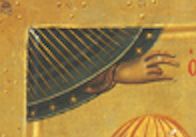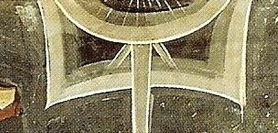As was mentioned before, the artistic portrayal of God was condemned by the Iconoclasts as idolatry, violating the First Commandment. John of Damascus, however, argued that since Christ had become visible, he could therefore be portrayed in an image. But what about the Father?
God the Father is more frequently manifested in the Old Testament while the Son is manifested in the New. Throughout the Old Testament, we receive only the most basic descriptions of a “form of God,” but each author is careful to emphasize that they did not see God’s actual appearance. In Ex 33-34, God promises to show Moses his glory on Mount Sinai. But Moses’ eyes are shielded from seeing anything but God’s “back” as God’s glory passes by him for, “man shall not see me and live” (Ex 33:20). In 1 Kings 19, Elijah is told to go out of his cave on Mount Horeb (Sinai) to meet with God. The account describes the Lord “passing by” but strangely, every effect of this- the earthquake, the strong wind, the fire- do not contain or even signify his presence. It is only in a still, small whisper- a far cry from any appearance- that Elijah recognizes that God is present. In Isaiah’s experience of God, he only sees the train of God’s robe filing the temple (Is 6). In Ezekiel’s account of God, he adds so many qualifiers to his description of God that one can’t help but see that he wishes to avoid giving any sort of physical description to God. Above the angels who appear to him he writes,
And above the firmament over their heads there was the likeness of a throne, in appearance like sapphire; and seated above the likeness of a throne was a likeness as it were of a human form. And upward from what had the appearance of his loins I saw as it were gleaming bronze, like the appearance of fire enclosed about; and downward from what had the appearance of his loins I saw as it were the appearance of fire, and there was brightness round about him. Like the appearance of the bow that is in the cloud on the day of rain, so was the appearance of the brightness round about. Such was the appearance of the likeness of the glory of the LORD. (Ez 1:26-28)
There is clearly an overwhelming reluctance to claim to have seen any sort of physical attribute of God. Even that semi-tantalizing description of the appearance of the likeness cannot go farther than his waist because of the appearance of fire and bronze above.
The reasons for this mystery were manifold. The Israelites, like all nations round about them, were constantly tempted to fall into idolatry. Even at Mount Sinai, as Moses is on the mountain receiving the Ten Commandments, the people attempt to make a golden calf, calling it YHWH, and are punished accordingly. God was adamant that he is not like other gods who could be contained or summed up in a piece of wood or gold, confined to one place, or could in the least way be portrayed in an artistic likeness. Even the sign of his presence amongst the Israelites- the Shekinah or “glory cloud”- was obscure and unmistakably not him.
Even St. John of Damascus scorned any portrayal of the Father in iconography. The iconographer can only portray in concrete forms what has been seen. Since the Father had never become man or taken any sort of appearance, it was completely illicit, idolatrous, and even heretical to portray him in artwork in any visible human form. To do so would be to commit idolatry and/or to add to scripture.
There is however, three valid ways of portraying the father’s presence in iconic scenes that do not betray this theology.
 1. The first example is known as the “Hand of God” and can be seen in the picture to the right (taken from an icon of John the Baptist). This hand can often include a wrist or a portion of arm above it and comes from a mandorla. Used in 2nd and 3rd century Jewish art, it was carried over to Christian iconography and used to indicate the Father’s approval of, or intervention in, the events on the Earth. The hand was never taken as literal, but simply a metaphor and is usually portrayed giving a blessing or performing an action. The other subjects in the icon, however, are not able to see the hand, because it was not physically visible at the event. It is usually affixed to the border of the icon at the top.
1. The first example is known as the “Hand of God” and can be seen in the picture to the right (taken from an icon of John the Baptist). This hand can often include a wrist or a portion of arm above it and comes from a mandorla. Used in 2nd and 3rd century Jewish art, it was carried over to Christian iconography and used to indicate the Father’s approval of, or intervention in, the events on the Earth. The hand was never taken as literal, but simply a metaphor and is usually portrayed giving a blessing or performing an action. The other subjects in the icon, however, are not able to see the hand, because it was not physically visible at the event. It is usually affixed to the border of the icon at the top.
 2. The second way is similar to the first. It simply portrays the mandorla at the top of the icon. A picture can be seen to the left (taken from an icon of the Baptism of the Lord above).
2. The second way is similar to the first. It simply portrays the mandorla at the top of the icon. A picture can be seen to the left (taken from an icon of the Baptism of the Lord above).
 3. The third way is to portray God’s presence with an angel who is acting as messenger of God. This is the most common way that God revealed himself to those he wished to talk to in the Old Testament. This way of representing God the Father is especially prevalent in icons depicting scenes from the Old Testament. Perhaps the most famous example of this is Rublev’s Hospitality of Abraham (right).
3. The third way is to portray God’s presence with an angel who is acting as messenger of God. This is the most common way that God revealed himself to those he wished to talk to in the Old Testament. This way of representing God the Father is especially prevalent in icons depicting scenes from the Old Testament. Perhaps the most famous example of this is Rublev’s Hospitality of Abraham (right).
All of this, to put it shortly, is to protect the sensitive theology of the icon and to avoid idolatry.
To see all posts on Iconography, click here.

